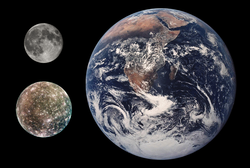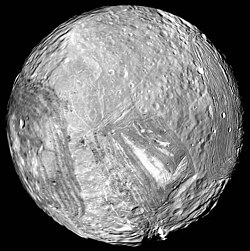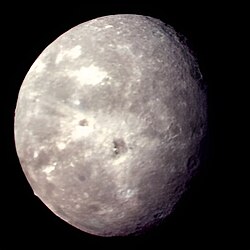PIA01478 Interior of Callisto
These findings come as a surprise, since scientists previously believed that Callisto was relatively inactive. If Callisto has an ocean, that would make it more like another Jovian moon, Europa, which has yielded numerous hints of a subsurface ocean. Despite the tantalizing suggestion that there is an ocean layer on Callisto, the possibility that there is life in the ocean remains remote.
Callisto's cratered surface lies at the top of an ice layer, (depicted here as a whitish band), which is estimated to be about 200 kilometers (124 miles) thick. Immediately beneath the ice, the thinner blue band represents the possible ocean, whose depth must exceed 10 kilometers (6 miles), according to scientists studying data from Galileo's magnetometer. The mottled interior is composed of rock and ice.
Galileo's magnetometer, which studies magnetic fields around Jupiter and its moons, revealed that Callisto's magnetic field is variable. This may be caused by varying electrical currents flowing near Callisto's surface, in response to changes in the background magnetic field as Jupiter rotates. By studying the data, scientists have determined that the most likely place for the currents to flow would be a layer of melted ice with a high salt content.
These findings were based on information gathered during Galileo's flybys of Callisto in November 1996, and June and September of 1997. JPL manages the Galileo mission for NASA's Office of Space Science, Washington, DC.Relevante Bilder
Relevante Artikel
EismondEismonde sind in der Astronomie natürliche Satelliten, deren Oberfläche vorwiegend aus Eis besteht. Ein solcher Himmelskörper besitzt eine Kryosphäre, die die gesamte Oberfläche des Körpers einnimmt und mitunter sehr voluminös sein kann. .. weiterlesen
Kallisto (Mond)Kallisto ist der vierte (äußerste) und zweitgrößte der vier großen Monde des Riesenplaneten Jupiter. Sie ist mit einem Durchmesser von 4820 km der drittgrößte Mond des Sonnensystems, nur geringfügig kleiner als der Planet Merkur. .. weiterlesen

















